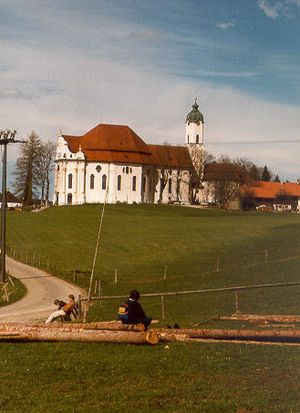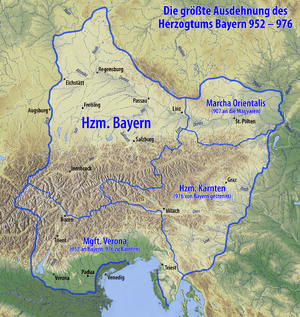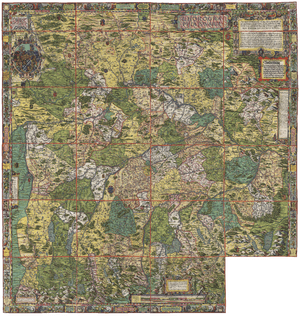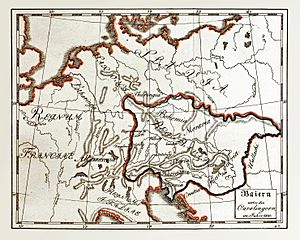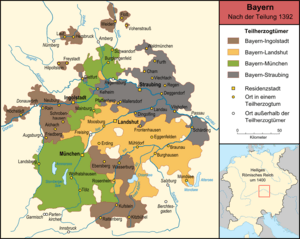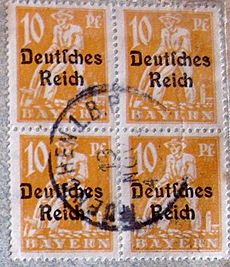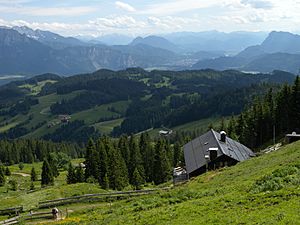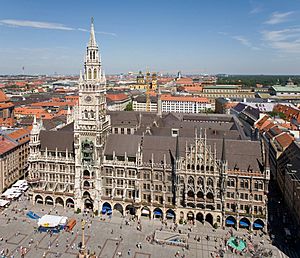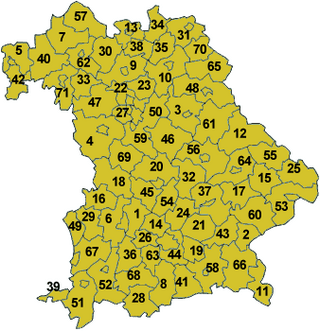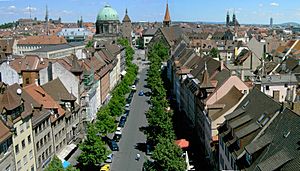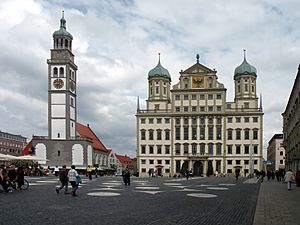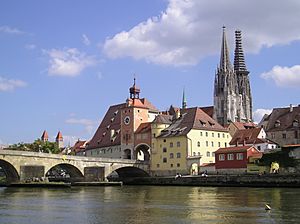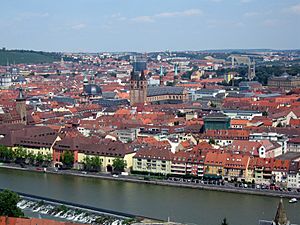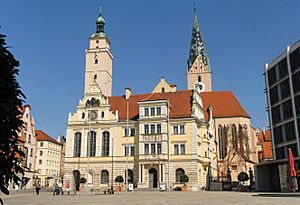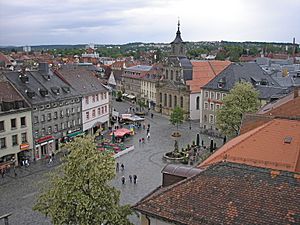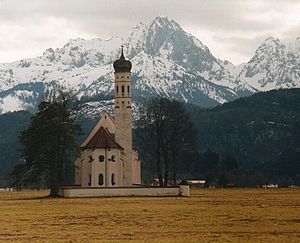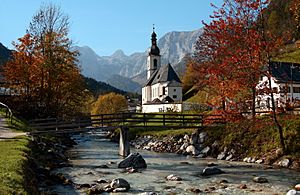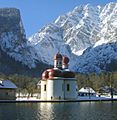Bavaria facts for kids
Quick facts for kids
Bavaria
Freistaat Bayern
|
|||
|---|---|---|---|
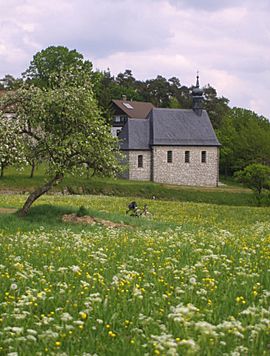
Village church in Franconia
|
|||
|
|||
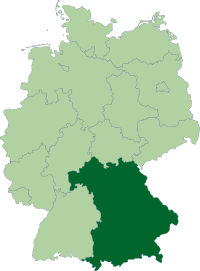
Position of Bavaria in Germany
|
|||
| Country | Germany | ||
| Capital | Munich | ||
| Area | |||
| • City | 70,549 km2 (27,239 sq mi) | ||
| Population
(11/2006)
|
|||
| • City | 12,495,000 | ||
| • Density | 177.111/km2 (458.715/sq mi) | ||
| Time zone | UTC+1 (CET) | ||
| • Summer (DST) | UTC+2 (CEST) | ||
| Website | bayern.de | ||
Bavaria (German: Bayern) is a State (Bundesland) of Germany. The territory of this state is the largest of the 16 German states. The state capital is Munich with 1.3 million people. About 12.5 million people live in Bavaria. Like many German states, Bavaria was once independent. Ludwig II of Bavaria was its last independent king.
Contents
History
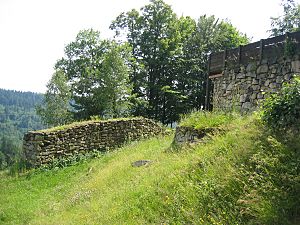
Antiquity
The Bavarians emerged in a region north of the Alps, previously inhabited by Celts, which had been part of the Roman provinces of Raetia and Noricum. The Bavarians spoke Old High German but, unlike other Germanic groups, probably did not migrate from elsewhere. Rather, they seem to have coalesced out of other groups left behind by Roman withdrawal late in the 5th century. These peoples may have included the Celtic Boii, some remaining Romans, Marcomanni, Allemanni, Quadi, Thuringians, Goths, Scirians, Rugians, Heruli. The name "Bavarian" ("Baiuvarii") means "Men of Baia" which may indicate Bohemia, the homeland of the Celtic Boii and later of the Marcomanni. They first appear in written sources circa 520. A 17th century Jewish chronicler David Solomon Ganz, citing Cyriacus Spangenberg, claimed that the diocese was named after an ancient Bohemian king, Boiia, in the 14th century BCE.
Middle Ages
From about 554 to 788, the house of Agilolfing ruled the Duchy of Bavaria, ending with Tassilo III who was deposed by Charlemagne.
Three early dukes are named in Frankish sources: Garibald I may have been appointed to the office by the Merovingian kings and married the Lombard princess Walderada when the church forbade her to King Chlothar I in 555. Their daughter, Theodelinde, became Queen of the Lombards in northern Italy and Garibald was forced to flee to her when he fell out with his Frankish overlords. Garibald's successor, Tassilo I, tried unsuccessfully to hold the eastern frontier against the expansion of Slavs and Avars around 600. Tassilo's son Garibald II seems to have achieved a balance of power between 610 and 616.
After Garibald II little is known of the Bavarians until Duke Theodo I, whose reign may have begun as early as 680. From 696 onwards he invited churchmen from the west to organize churches and strengthen Christianity in his duchy (it is unclear what Bavarian religious life consisted of before this time). His son, Theudebert, led a decisive Bavarian campaign to intervene in a succession dispute in the Lombard Kingdom in 714, and married his sister Guntrud to the Lombard King Liutprand. At Theodo's death the duchy was divided among his sons, but reunited under his grandson Hugbert.
At Hugbert's death (735) the duchy passed to a distant relative named Odilo, from neighbouring Alemannia (modern southwest Germany and northern Switzerland). Odilo issued a law code for Bavaria, completed the process of church organisation in partnership with St. Boniface (739), and tried to intervene in Frankish succession disputes by fighting for the claims of the Carolingian Grifo. He was defeated near Augsburg in 743 but continued to rule until his death in 748. Saint Boniface completed the people's conversion to Christianity in the early 8th century. Bavaria was in many ways affected by the Protestant Reformation in the 16th century.
Tassilo III (b. 741 - d. after 796) succeeded his father at the age of eight after an unsuccessful attempt by Grifo to rule Bavaria. He initially ruled under Frankish oversight but began to function independently from 763 onwards. He was particularly noted for founding new monasteries and for expanding eastwards, fighting Slavs in the eastern Alps and along the River Danube and colonising these lands. After 781, however, his cousin Charlemagne began to pressure Tassilo to submit and finally deposed him in 788. The deposition was not entirely legitimate. Dissenters attempted a coup against Charlemagne at Tassilo's old capital of Regensburg in 792, led by his own son Pépin the Hunchback. The king had to drag Tassilo out of imprisonment to formally renounce his rights and titles at the Assembly of Frankfurt in 794. This is the last appearance of Tassilo in the sources, and he probably died a monk. As all of his family were also forced into monasteries, this was the end of the Agilolfing dynasty.
For the next 400 years numerous families held the duchy, rarely for more than three generations. With the revolt of duke Henry the Quarrelsome in 976, Bavaria lost large territories in the south and south east. The territory of Ostarrichi was elevated to a duchy in its own right and given to the Babenberger family. This event marks the founding of Austria.
The last, and one of the most important, of the dukes of Bavaria was Henry the Lion of the house of Welf, founder of Munich, and de facto the second most powerful man in the empire as the ruler of two duchies. When in 1180, Henry the Lion was deposed as Duke of Saxony and Bavaria by his cousin, Frederick I, Holy Roman Emperor (a.k.a. "Barbarossa" for his red beard), Bavaria was awarded as fief to the Wittelsbach family, counts palatinate of Schyren ("Scheyern" in modern German). They ruled for 738 years, from 1180 to 1918. The Electorate of the Palatinate by Rhine (Kurpfalz in German) was also acquired by the House of Wittelsbach in 1214, which they would subsequently hold for six centuries.
The first of several divisions of the duchy of Bavaria occurred in 1255. With the extinction of the Hohenstaufen in 1268, Swabian territories were acquired by the Wittelsbach dukes. Emperor Louis the Bavarian acquired Brandenburg, Tyrol, Holland and Hainaut for his House but released the Upper Palatinate for the Palatinate branch of the Wittelsbach in 1329. In the 14th and 15th centuries, upper and lower Bavaria were repeatedly subdivided. Four Duchies existed after the division of 1392: Bavaria-Straubing, Bavaria-Landshut, Bavaria-Ingolstadt and Bavaria-Munich. In 1506 with the Landshut War of Succession, the other parts of Bavaria were reunited, and Munich became the sole capital.
Electorate of Bavaria
In 1623 the Bavarian duke replaced his relative of the Palatinate branch, the Electorate of the Palatinate in the early days of the Thirty Years' War and acquired the powerful prince-electoral dignity in the Holy Roman Empire, determining its Emperor thence forward, as well as special legal status under the empire's laws. The country became one of the Jesuit supported counter-reformation centers. During the early and mid-18th century the ambitions of the Bavarian prince electors led to several wars with Austria as well as occupations by Austria (War of the Spanish Succession, election of a Wittelsbach emperor instead of a Habsburger). From 1777 onwards and after the younger Bavarian branch of the family had died out with elector Max III Joseph, Bavaria and the Electorate of the Palatinate were governed once again in personal union, now by the Palatinian lines. The new state also comprised the Duchies of Jülich and Berg as these on their part were in personal union with the Palatinate.
Kingdom of Bavaria
When Napoleon abolished the Holy Roman Empire, Bavaria became a kingdom in 1806 due, in part, to the Confederation of the Rhine. Its area doubled after the Duchy of Jülich was ceded to France, as the Electoral Palatinate was divided between France and the Grand Duchy of Baden. The Duchy of Berg was given to Jerome Bonaparte. The Tyrol and Salzburg were temporarily reunited with Bavaria but finally ceded to Austria by the Congress of Vienna. In return Bavaria was allowed to annex the modern-day region of Palatinate to the left of the Rhine and Franconia in 1815. Between 1799 and 1817, the leading minister, Count Montgelas, followed a strict policy of modernisation; he laid the foundations of administrative structures that survived the monarchy and retain core validity in the 21st century. In May 1808 a first constitution was passed by Maximilian I, being modernized in 1818. This second version established a bicameral Parliament with a House of Lords (Kammer der Reichsräte) and a House of Commons (Kammer der Abgeordneten). That constitution was followed until the collapse of the monarchy at the end of World War I.
After the rise of Prussia to power, Bavaria preserved its independence by playing off the rivalries of Prussia and Austria. Allied to Austria, it was defeated in the 1866 Austro-Prussian War and did not belong to the North German Federation of 1867, but the question of German unity was still alive. When France declared war on Prussia in 1870, the south German states Baden, Württemberg, Hessen-Darmstadt and Bavaria joined the Prussian forces and ultimately joined the Federation, which was renamed Deutsches Reich (German Empire) in 1871. Bavaria continued as a monarchy, and it had some special rights within the federation (such as an army, railways and a postal service of its own).
Part of the German Empire
When Bavaria became part of the newly formed German Empire, this action was considered controversial by Bavarian nationalists who had wanted to retain independence. As Bavaria had a majority-Catholic population, many people resented being ruled by the mostly Protestant northerners of Prussia. As a direct result of the Bavarian-Prussian feud, political parties formed to encourage Bavaria to break away and regain its independence. Although the idea of Bavarian separatism was popular in the late 19th and early 20th century, apart from a small minority such as the Bavaria Party, most Bavarians have accepted that Bavaria is part of Germany.
In the early-20th century, Wassily Kandinsky, Paul Klee, Henrik Ibsen, and other notable artists were drawn to Bavaria, notably to the Schwabing district of Munich, a center of international artistic activity. This area was devastated by bombing and invasion during World War II.
Free State of Bavaria
Free State has been an adopted designation after the abolition of monarchy in the aftermath of World War I in several German states. On 12 November 1918, Ludwig III signed a document, the Anif declaration, releasing both civil and military officers from their oaths; the newly formed republican government of Socialist premier Kurt Eisner interpreted this as an abdication. To date, however, no member of the house of Wittelsbach has ever formally declared renunciation of the throne. On the other hand, none has ever since officially called upon their Bavarian or Stuart claims. Family members are active in cultural and social life, including the head of the house, Franz, Duke of Bavaria. They step back from any announcements on public affairs, showing approval or disapproval solely by Franz's presence or absence.
Bavarian identity
Bavarians have often emphasized a separate national identity and considered themselves as "Bavarians" first, "Germans" second. This feeling started to come about more strongly among Bavarians when the Kingdom of Bavaria joined the Protestant Prussian-dominated German Empire while the Bavarian nationalists wanted to keep Bavaria as Catholic and an independent state. Nowadays, aside from the minority Bavaria Party, most Bavarians accept that Bavaria is part of Germany. Another consideration is that Bavarians foster different cultural identities: Franconia in the north, speaking East Franconian German; Bavarian Swabia in the south west, speaking Swabian German; and Altbayern (so-called "Old Bavaria", the regions forming the "historic", pentagon-shaped Bavaria before the acquisitions through the Vienna Congress, at present the districts of the Upper Palatinate, Lower and Upper Bavaria) speaking Austro-Bavarian. In Munich, the Old Bavarian dialect was widely spread, but nowadays High German is predominantly spoken there.
Coat of arms

The modern coat of arms of Bavaria was designed by Eduard Ege in 1946, following heraldic traditions.
- The Golden Lion: At the dexter chief, sable, a lion rampant Or, armed and langued gules. This represents the administrative region of Upper Palatinate.
- The "Franconian Rake": At the sinister chief, per fess dancetty, gules and argent. This represents the administrative regions of Upper, Middle and Lower Franconia.
- The Blue "Pantier" (mythical creature from French heraldry, sporting a flame instead of a tongue): At the dexter base, argent, a Pantier rampant azure, armed Or and langued gules. This represents the regions of Lower and Upper Bavaria.
- The Three Lions: At the sinister base, Or, three lions passant guardant sable, armed and langued gules. This represents Swabia.
- The White-And-Blue inescutcheon: The inescutcheon of white and blue fusils askance was originally the coat of arms of the Counts of Bogen, adopted in 1247 by the House of Wittelsbach. The white-and-blue fusils are indisputably the emblem of Bavaria and these arms today symbolize Bavaria as a whole. Along with the People's Crown, it is officially used as the Minor Coat of Arms.
- The People's Crown (Volkskrone): The coat of arms is surmounted by a crown with a golden band inset with precious stones and decorated with five ornamental leaves. This crown first appeared in the coat of arms to symbolize sovereignty of the people after the royal crown was eschewed in 1923.
Geography
Bavaria shares international borders with Austria (Salzburg, Tyrol, Upper Austria and Vorarlberg) and the Czech Republic (Karlovy Vary, Plzeň and South Bohemian Regions) as well as with Switzerland (across Lake Constance to the Canton of St. Gallen). Because all of these countries are part of the Schengen Area, the border is completely open. Neighbouring states within Germany are Baden-Württemberg, Hesse, Thuringia and Saxony. Two major rivers flow through the state: the Danube (Donau) and the Main. The Bavarian Alps define the border with Austria (including the Austrian federal-states of Vorarlberg, Tyrol and Salzburg), and within the range is the highest peak in Germany: the Zugspitze. The Bavarian Forest and the Bohemian Forest form the vast majority of the frontier with the Czech Republic and Bohemia.
The major cities in Bavaria are Munich (München), Nuremberg (Nürnberg), Augsburg, Regensburg, Würzburg, Ingolstadt, Fürth and Erlangen.
Administrative divisions
Bavaria is divided into 7 administrative districts called Regierungsbezirke (singular Regierungsbezirk).
Regierungsbezirke (Administrative districts)
- Altbayern:
- Upper Palatinate (German: Oberpfalz)
- Upper Bavaria (Oberbayern)
- Lower Bavaria (Niederbayern)
- Upper Franconia (Oberfranken)
- Middle Franconia (Mittelfranken)
- Lower Franconia (Unterfranken)
- Swabia (Schwaben)
Population and area
| Administrative region | Capital | Population (2011) | Area (km2) | No. municipalities | |||
|---|---|---|---|---|---|---|---|
| Lower Bavaria | Landshut | 1,192,641 | 9.48% | 10,330 | 14.6% | 258 | 12.5% |
| Lower Franconia | Würzburg | 1,315,882 | 10.46% | 8,531 | 12.1% | 308 | 15.0% |
| Upper Franconia | Bayreuth | 1,067,988 | 8.49% | 7,231 | 10.2% | 214 | 10.4% |
| Middle Franconia | Ansbach | 1,717,670 | 13.65% | 7,245 | 10.3% | 210 | 10.2% |
| Upper Palatinate | Regensburg | 1,081,800 | 8.60% | 9,691 | 13.7% | 226 | 11.0% |
| Swabia | Augsburg | 1,788,729 | 14.21% | 9,992 | 14.2% | 340 | 16.5% |
| Upper Bavaria | Munich | 4,418,828 | 35.12% | 17,530 | 24.8% | 500 | 24.3% |
| Total | 12,583,538 | 100.0% | 70,549 | 100.0% | 2,056 | 100.0% | |
Bezirke
Bezirke (districts) are the third communal layer in Bavaria; the others are the Landkreise and the Gemeinden or Städte. The Bezirke in Bavaria are territorially identical with the Regierungsbezirke (e.g. Regierung von Oberbayern), but are a different form of administration, having their own parliaments, etc. In the other larger states of Germany, there are Regierungsbezirke which are only administrative divisions and not self-governing entities as the Bezirke in Bavaria.
Landkreise/kreisfreie cities
These administrative regions consist of 71 administrative districts (called Landkreise, singular Landkreis, e.g. rural districts) and 25 independent cities (kreisfreie Städte, singular kreisfreie Stadt, e.g. urban districts) that are comparable to Counties (only that there is no distinction between "Ceremonial" and "Administrative" and all have the same administrative responsibilities).
Landkreise:
Kreis-free Cities:
Gemeinden (municipalities)
The 71 administrative districts are on the lowest level divided into 2031 regular municipalities (called Gemeinden, singular Gemeinde). Together with the 25 independent cities (kreisfreie Städte, which are in effect municipalities independent of Landkreis administrations), there are a total of 2056 municipalities in Bavaria.
In 44 of the 71 administrative districts, there are a total of 215 unincorporated areas (as of January 1, 2005, called gemeindefreie Gebiete, singular gemeindefreies Gebiet), not belonging to any municipality, all uninhabited, mostly forested areas, but also four lakes (Chiemsee-without islands, Starnberger See-without island Roseninsel, Ammersee, which are the three largest lakes of Bavaria, and Waginger See).
Major cities
| City | Region | Inhabitants 31 December 2000 |
Inhabitants 31 December 2005 |
Inhabitants 31 December 2010 |
Inhabitants 31 December 2015 |
Changes 2000 – 2010 in % |
|---|---|---|---|---|---|---|
| Munich | Upper Bavaria | 1,210,223 | 1,259,677 | 1,353,186 | 1,450,381 | +11.81 |
| Nuremberg | Middle Franconia | 488,400 | 499,237 | 505,664 | 509,975 | +3.53 |
| Augsburg | Swabia | 254,982 | 262,676 | 264,708 | 286,374 | +3.81 |
| Regensburg | Upper Palatinate | 125,676 | 129,859 | 135,520 | 145,465 | +7.83 |
| Ingolstadt | Upper Bavaria | 115,722 | 121,314 | 125,088 | 132,438 | +8.09 |
| Würzburg | Lower Franconia | 127,966 | 133,906 | 133,799 | 124,873 | +4.56 |
| Fürth | Middle Franconia | 110,477 | 113,422 | 114,628 | 124,171 | +3.76 |
| Erlangen | Middle Franconia | 100,778 | 103,197 | 105,629 | 108,336 | +4.81 |
| Bayreuth | Upper Franconia | 74,153 | 73,997 | 72,683 | 72,148 | −1.98 |
| Bamberg | Upper Franconia | 69,036 | 70,081 | 70,004 | 73,331 | +1.40 |
| Aschaffenburg | Lower Franconia | 67,592 | 68,642 | 68,678 | 68,986 | +1.61 |
| Landshut | Lower Bavaria | 58,746 | 61,368 | 63,258 | 69,211 | +7.68 |
| Kempten (Allgäu) | Swabia | 61,389 | 61,360 | 62,060 | 66,947 | +1.09 |
| Rosenheim | Upper Bavaria | 58,908 | 60,226 | 61,299 | 61,844 | +4.06 |
| Neu-Ulm | Swabia | 50,188 | 51,410 | 53,504 | 57,237 | +6.61 |
| Schweinfurt | Lower Franconia | 54,325 | 54,273 | 53,415 | 51,969 | −1.68 |
| Passau | Lower Bavaria | 50,536 | 50,651 | 50,594 | 50,566 | +0.11 |
| Freising | Upper Bavaria | 40,890 | 42,854 | 45,223 | 46,963 | +10.60 |
| Straubing | Lower Bavaria | 44,014 | 44,633 | 44,450 | 46,806 | +0.99 |
| Dachau | Upper Bavaria | 38,398 | 39,922 | 42,954 | 46,705 | +11.87 |
Government and politics
Government
The Constitution of Bavaria of the free state of Bavaria was enacted on 8 December 1946. The new Bavarian Constitution became the basis for the Bavarian State after the Second World War.
Bavaria has a unicameral Landtag, or state parliament, elected by universal suffrage. Until December 1999, there was also a Senat, or Senate, whose members were chosen by social and economic groups in Bavaria, but following a referendum in 1998, this institution was abolished.
The Bavarian State Government consists of the Minister-President of Bavaria, 11 Ministers and 6 Secretaries of State. The Minister-President is elected for a period of five years by the State Parliament and is head of state. With the approval of the State Parliament he appoints the members of the State Government. The State Government is composed of the:
Designation as a "free state"
Unlike most German states (Länder), which simply designate themselves as "State of X" (Land X), Bavaria uses the style of "Free State of Bavaria" (Freistaat Bayern).
Economy
Bavaria has long had one of the largest economies of any region in Germany, or Europe for that matter. Its GDP in 2007 exceeded 434 billion Euros (about 600 bn US$). This makes Bavaria itself one of the largest economies in Europe and only 20 countries in the world have a higher GDP. Some large companies headquartered in Bavaria include BMW, Siemens, Rohde & Schwarz, Audi, Munich Re, Allianz, Infineon, MAN, Wacker Chemie, Puma, Adidas, and Ruf. Bavaria has a GDP per capita of over $48,000 US, meaning that if it were its own independent country it would rank 7th or 8th in the world.
Company names
The motorcycle and automobile makers BMW (Bayerische Motoren-Werke, or Bavarian Motor Works) and Audi, Allianz, Grundig (consumer electronics), Siemens (electricity, telephones, informatics, medical instruments), Continental (Automotive Tire and Electronics), Nintendo, Adidas, Puma, HypoVereinsbank (UniCredit Group), Infineon, Krauss-Maffei Wegmann and Ruf have (or had) a Bavarian industrial base.
Demographics
The population of Bavaria is 12,843,514 (2015). Countries of origin of the major immigrant groups are as listed below:
| Rank | Nationality | Population estimate (2014) |
|---|---|---|
| 1 | 199,215 | |
| 2 | 118,208 | |
| 3 | 104,336 | |
| 4 | 96,656 | |
| 5 | 85,339 | |
| 6 | 76,815 | |
| 7 | 72,027 | |
| 8 | 64,818 | |
| 9 | 40,111 | |
| 10 | 40,111 |
Culture
| Religion in Bavaria - 2014 | ||||
|---|---|---|---|---|
| religion | percent | |||
| Catholics | 52% | |||
| EKD Protestants | 20% | |||
| Muslims | 4% | |||
| Other or none | 24% | |||
Some features of the Bavarian culture and mentality are remarkably distinct from the rest of Germany. Noteworthy differences (especially in rural areas, less significant in the major cities) can be found with respect to:
Religion
Bavarian culture (Altbayern) has a long and predominant tradition of Catholic faith. Pope emeritus Benedict XVI (Joseph Alois Ratzinger) was born in Marktl am Inn in Upper Bavaria and was Cardinal-Archbishop of Munich and Freising. Otherwise, the culturally Franconian and Swabian regions of the modern State of Bavaria are historically more diverse in religiosity, with both Catholic and Protestant traditions. In 1925, 70.0% of the Bavarian population was Catholic, 28.8% was Protestant, 0.7% was Jewish, and 0.5% was placed in other religious categories.
As of 2014[update] 52.1% of Bavarians still adhered to Catholicism though the number is on the decline (they were 70.4% in 1970, 56.3% in 2007). 19.5% of the population adheres to the Evangelical Lutheran Church in Bavaria, and their number is declining too. Muslims make up 4.0% of the population of Bavaria. 24% of Bavarians are irreligious or adhere to other religions, and this number is increasing.
Traditions
Bavarians commonly emphasize pride in their traditions. Traditional costumes collectively known as Tracht are worn on special occasions and include in Altbayern Lederhosen for males and Dirndl for females. Centuries-old folk music is performed. The Maibaum, or Maypole (which in the Middle Ages served as the community's yellow pages, as figurettes on the pole represent the trades of the village), and the bagpipes in the Upper Palatinate region bear witness to the ancient Celtic and Germanic remnants of cultural heritage of the region. There are a lot of traditional Bavarian sports disciplines, e.g. the Aperschnalzen is an old tradition of competitive whipcracking.
Whether actually in Bavaria, overseas or full of citizens from other nations they continue to cultivate their traditions. They hold festivals and dances to keep their traditions alive. In New York the German American Cultural Society is a larger umbrella group for others such as the Bavarian organizations, which represent a specific part of Germany. They proudly put forth a German Parade called Steuben Parade each year. Various affiliated events take place amongst its groups, one of which is the Bavarian Dancers.
Food and drink
Bavarians tend to place a great value on food and drink. In addition to their renowned dishes, Bavarians also consume many items of food and drink which are unusual elsewhere in Germany; for example Weißwurst ("white sausage") or in some instances a variety of entrails. At folk festivals and in many beer gardens, beer is traditionally served by the litre (in a Maß). Bavarians are particularly proud of the traditional Reinheitsgebot, or purity law, initially established by the Duke of Bavaria for the City of Munich (e.g. the court) in 1487 and the duchy in 1516. According to this law, only three ingredients were allowed in beer: water, barley, and hops. In 1906 the Reinheitsgebot made its way to all-German law, and remained a law in Germany until the EU partly struck it down recently as incompatible with the European common market. German breweries, however, cling to the principle, and Bavarian breweries still comply with it in order to distinguish their beer blend. Bavarians are also known as some of the world's most beer-loving people with an average annual consumption of 170 litres per person, although figures have been declining in recent years.
Bavaria is also home to the Franconia wine region, which is situated along the Main River in Franconia. The region has produced wine (Frankenwein) for over 1,000 years and is famous for its use of the Bocksbeutel wine bottle. The production of wine forms an integral part of the regional culture, and many of its villages and cities hold their own wine festivals (Weinfeste) throughout the year.
Language and dialects
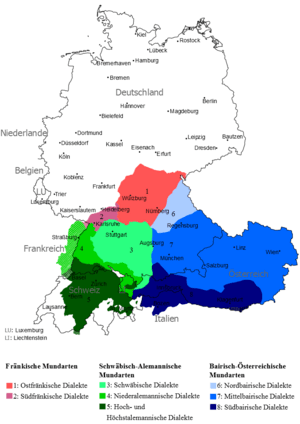
Mainly three German dialects are spoken in Bavaria: Austro-Bavarian in Old Bavaria (South-East and East), Swabian German (an Alemannic German dialect) in the Bavarian part of Swabia (South West) and East Franconian German in Franconia (North). In the small town Ludwigsstadt in the north, district Kronach in Upper Franconia, Thuringian dialect is spoken. In the 20th century an increasing part of the population began to speak Standard German, mainly in the cities.
Sports

Football
Bavaria is home to several football clubs including FC Bayern Munich, 1. FC Nuremberg, FC Augsburg, TSV 1860 München, FC Ingolstadt 04 and SpVgg Greuther Fürth. Bayern Munich is the most popular and successful football team in Germany having won a record 27 German titles. They are followed by 1.FC Nuremberg who have won 9 titles. SpVgg Greuther Fürth have won 3 championships while TSV 1860 München have been champions once. FC Bayern won the 2013 UEFA Champions League final.
Historical buildings
-
Veste Coburg in Coburg
-
Festspielhaus of Richard Wagner in Bayreuth
-
Imperial Castle in Nuremberg
-
Kastell Biriciana, Weissenburg close to the Limes
-
Kreuztor in Ingolstadt
-
Old Stone Bridge and Cathedral of Regensburg
Images for kids
-
Expression of Bavarian (linguistic) identity in a shop window in the town of Regensburg, Upper Palatinate
-
Munich city center with Frauenkirche (left) and Rathaus (town hall)
-
Regensburg with the Danube (foreground) and Regensburg Cathedral
-
A Catholic church near Füssen with the Alps in the background
-
Upper German and the southern counterpart to Central German both form the High German languages, while the Austro-Bavarian dialects are in blue
See also
 In Spanish: Baviera para niños
In Spanish: Baviera para niños



